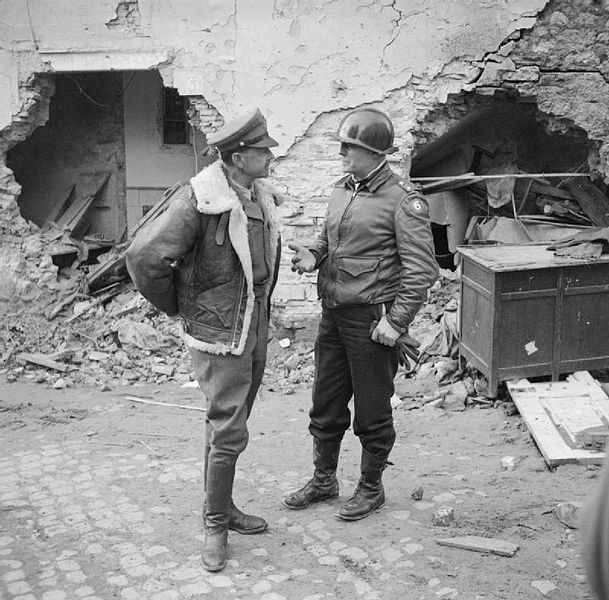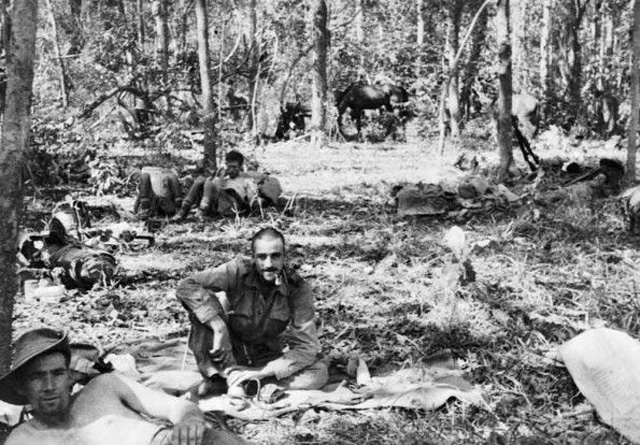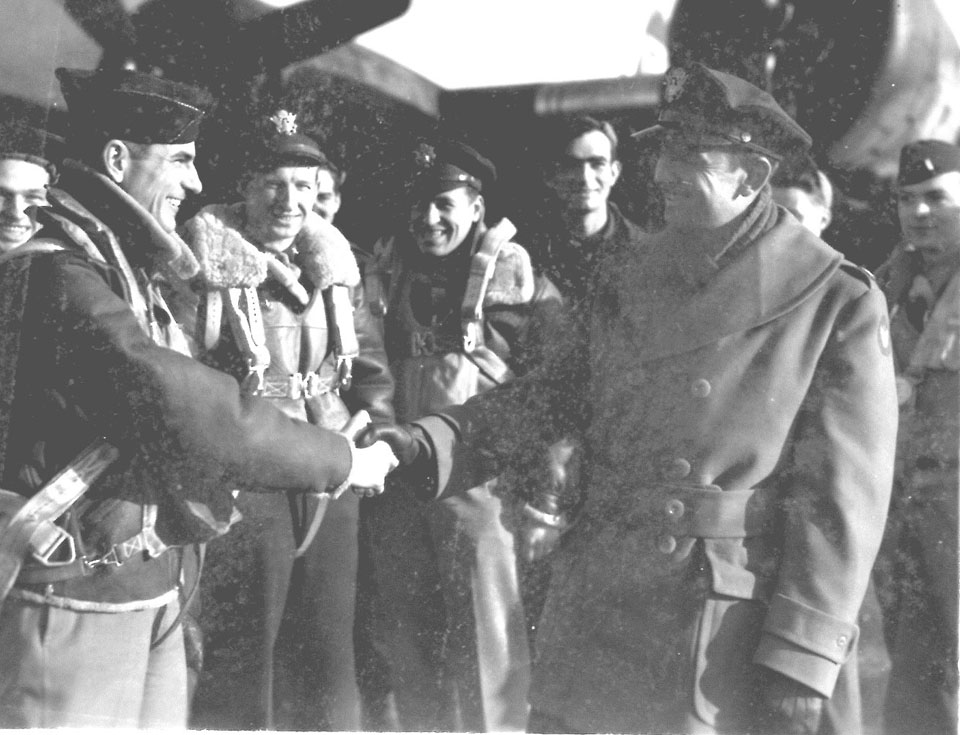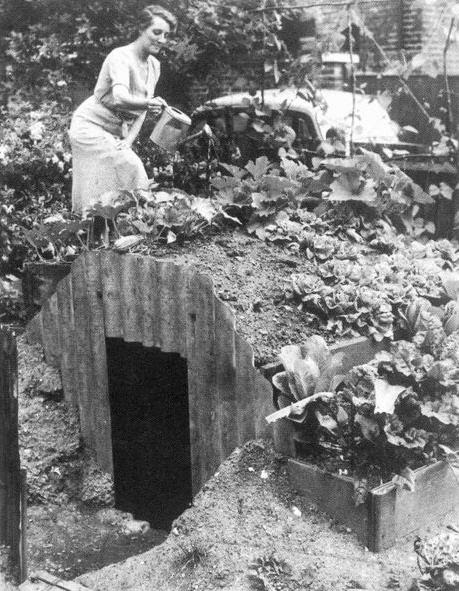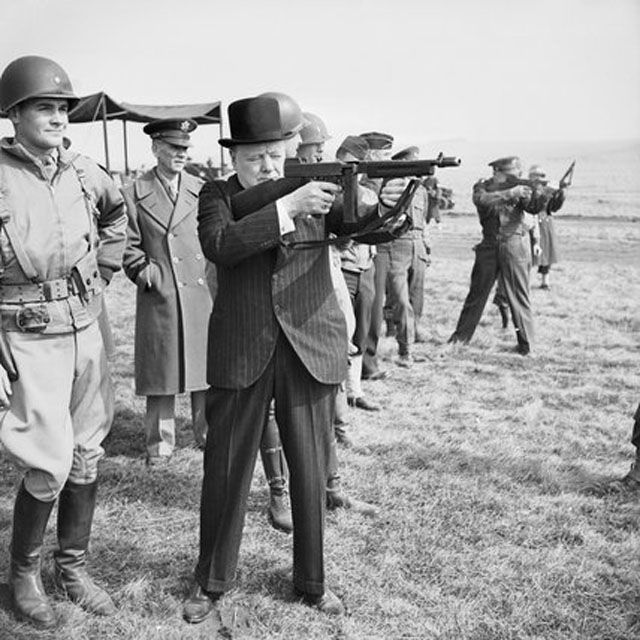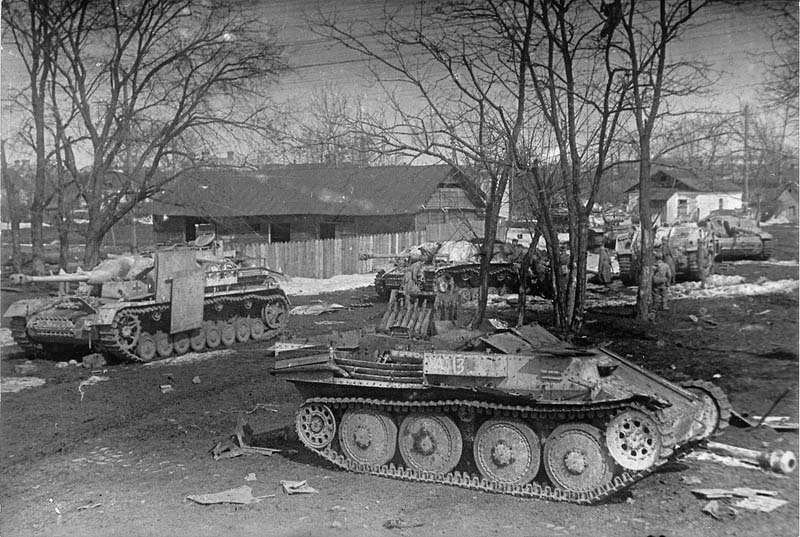Admiralty Islands
Adm Victor A. C. Crutchley's cruiser TF 74 shells Japanese batteries on Hauwei and Ndrilo which have been hampering access to Seeadler Bay. US reinforcments, the 2nd Squadron, 7th Cavalry and the 82nd Field Artillery Battalion, are landed on Los Negros. The 2nd Squadron, 7th Cavalry, replaces the 2nd Squadron, 5th Cavalry.
[Air Operations, CBI
BURMA- More than 60 10th Air Force P-51s, P-40s, and A-36s attack road targets, dumps, and bivouacs over a wide area.
- 6 11th Medium Bomb Squadron B-25s attack the airfield at Kiungshan on northern Hainan Island with parafrag bomb clusters dropped at high speed and from only 150 feet of altitude. An estimated 20 Japanese airplanes are destroyed by the bomb clusters and strafing, and 3 of the B-25s are only slightly damaged by ground fire. In addition, a 3rd CACW Fighter Group P-40 escort downs a twin-engine airplane in a multi-plane engagement over the airfield at 1225 hours.
- 2 CACW B-25s, escorted by 4 449th Fighter Squadron P-38s, attack shipping on the Yangtze River. When they are attacked by 10 Ki-43 'Oscar' fighters, the 449th Fighter Squadron P-38 escorts down 3 of the 'Oscars' over Shihweiyao at 1305 hours. 2 P-38s are damaged beyond repair in crash landings at the airfield at Suichwan.
- A P-51 with the 23rd Fighter Groupís 76th Fighter Squadron downs 1 Ki-43 'Oscar' fighter over Wuhu at an unstated time.
- Japanese bombers cause considerable damage during an uncontested attack against the Suichwan airfield.
- 6 341st Medium Bomb Group B-25s attack port facilities at Campha and a chromium mine at Thanh Hoa. 2 14th Air Force P-40s attack rail facilities and warehouses at Campha and Hongay. 5 P-40s sent against Cao Bang accidently attack the Chinese city of Lungchow, because of bad weather.
Air Operations, Europe
About 600(30?) Flying Fortresses and Liberators of the US 8th Air Force carry out the first daylight raid on Berlin. Because of bad weather over the target area, the raid is diverted to bomb Cologne, Bonn, Düsseldorf and Frankfurt instead. They meet with powerful resistance by fighters and anti-aircraft guns and lose nearly 80 aircraft.
RAF BOMBER COMMANDEvening Ops:
- 15 Mosquitos are sent to Berlin, 6 to Duisburg, 1 to Aachen and 1 to Sottevaast, 10 Halifaxes lay mines off Brest, 76 aircraft are involved in Resistance operations, and 16 Lancasters of No. 617 Squadron are sent to bomb the La Ricamerie needle-bearing factory near Lyons, but are unable to locate the target because of clouds and return without bombing.
- There are no losses.
GERMANY:
- Although 502 1st and 3rd Bomb Division B-17s are dispatched to attack industrial suburbs of Berlin, unfavorable weather conditions over most of Germany prevent all but one 30-plane 3rd Division combat wing from reaching its primary target. A total of 219 1st and 3rd Bomb Division B-17s attack targets of opportunity in the Ruhr.
- Of the 30-plane raid, 5 B-17s are lost, 10 B-17s are lost over the Ruhr
- Of 770 USAAF fighters dispatched, a record 24 fail to return to their bases. Of these, it appears 11 of 33 P-51s dispatched by the 363rd Fighter Group are lost in weather-related accidens over the Dutch coast. VIII Fighter Command escort pilots down 7 Luftwaffe over Germany between 1215 and 1340 hours.
FRANCE:
- 251 IX Bomber Command B-26s and 21 A-20s dispatched against several airfields in France abort in the face of heavy cloud cover over the targets.
ITALY:
- Most of the 12th Air Force is grounded by bad weather, but a few XII Air Support Command P-40s attack gun emplacements in the battle area.
Air Operations, Marshalls
- 7th Air Force and 4th Marine Base Defense Aircraft Wing squadrons (including attached US Navy squadrons) based in the Marshall and Gilbert islands open an organized and methodical offensive to neutralize bypassed Japanese bases in the region, especially at the Jaluit, Maloelap, Mille, and Wotje atolls.
- On this first day of what will be a very long operation, strong antiaircraft opposition is encountered, especially by Majuro-based VMSB-331 SBDs engaged in an attack against the Jaluit Atoll. As a result, target plans are altered in favor of a heavy early campaign emphasis against antiaircraft defenses.
Air Operations, New Guinea
- Throughout the day, 16 V Bomber Command B-25s and 12 A-20s brave bad weather to bomb and strafe Japanese Army ground troops on Los Negros Island. More than 30 V Bomber Command B-24s attack airfields in the Wewak area. 22 B-24s attack Hollandia. A-20s attack artillery batteries and buildings in the Saidor area.
- 35th Fighter Group P-47s down 2 Japanese fighters in the Wewak area at 1115 hours, and 2 fighters over the Bogadjim road at 1220 hours.
- During the might, V Bomber Command bombers open a series of light harrassing raids against Hollandia-area airfields.
Arctic
U-472 is spotted on the surface by Swordfish 'B' of 816 NAS from HMS Chaser for the passage of convoy RA-57 from the Kola Inlet. The aircraft attacks and scores two hit with bombs on the hull. The U-boat begins to leak oil and her course becomes very erratic. A call is put out to the British destroyer HMS Onslaught. When the destroyer is within range, she opens up with her 4.7-in main armament but the submarine is already sinking. The Onslaught starts trying to rescue the crew of the U-boat.
| Class | Type VIIC |
| CO | Oberleutnant zur See Wolfgang-Friedrich Freiherr von Forstner |
| Location | Arctic, N of North Cape |
| Cause | Depth charge |
| Casualties | 23 |
| Survivors | 30 |
CBI
BURMAIn Burma, the 3rd and 2nd Battalions of the Marauders complete roadblocks on the Kamaing Road. The Japanese unsuccessfully attack the 3rd Battalion at Lagang Ga, now in established defensive positions. The 1st Provisional Tank Group, finding the Japanese have withdrawn, advances about 3 miles southeast from Ngam Ga to Tsamat Ga, near Maingkwan.
CHINAGen Stilwell, Chiang Kai-shek's Chief of Staff, meets Adm Lord Mountbatten, Allied Supreme Commander in Southeast Asia. During their discussions some of their differences over the conduct of operations in the Far East are smoothed out.
[Eastern Front
The Soviets begin another series of massive attacks in the Ukraine with advances by Vatutin's forces in the area to the north and east of Tarnopol. They drive the German forces back over the Bug, although they still have forces in Uman between Kiev and Odessa, and surround some enemy divisions in the area of Tarnopol. Apart from brief lulls the Russian offensive goes on without a break for over 3 months.
SOUTHERN SECTORSupported by overwhelming arty fire and air interdiction, the 1st Ukrainian Front opens its offensive against the 4th and 1st Panzer Armies. The 1st Guards and 60th Armies smash into the LIX and XIII Corps, inflicting severe casualties. Within hours a breakthrough is achieved and the LIX Corps begins to fall back to the west.
[Green Islands
A landing strip for Allied fighters is operational, and a runway for bombers nears completion.
[Italy
There is a lull at Anzio. German troops are told to hold their positions and prepare for defensive action.
[Pacific
- The US submarine Bluefish (SS-222) attacks a Japanese convoy in the South China Sea and sinks the oiler Ominesan Maru (10,536t) about 300 miles west of Miri, Sarawak.
- The US submarine Peto (SS-265) attacks a Japanese convoy and sinks the army cargo ship Kayo Maru (4368t) 75 miles west-nortwest of Hollandia.
Images from March 4, 1944
|
|
|
|
|
|
|
|
